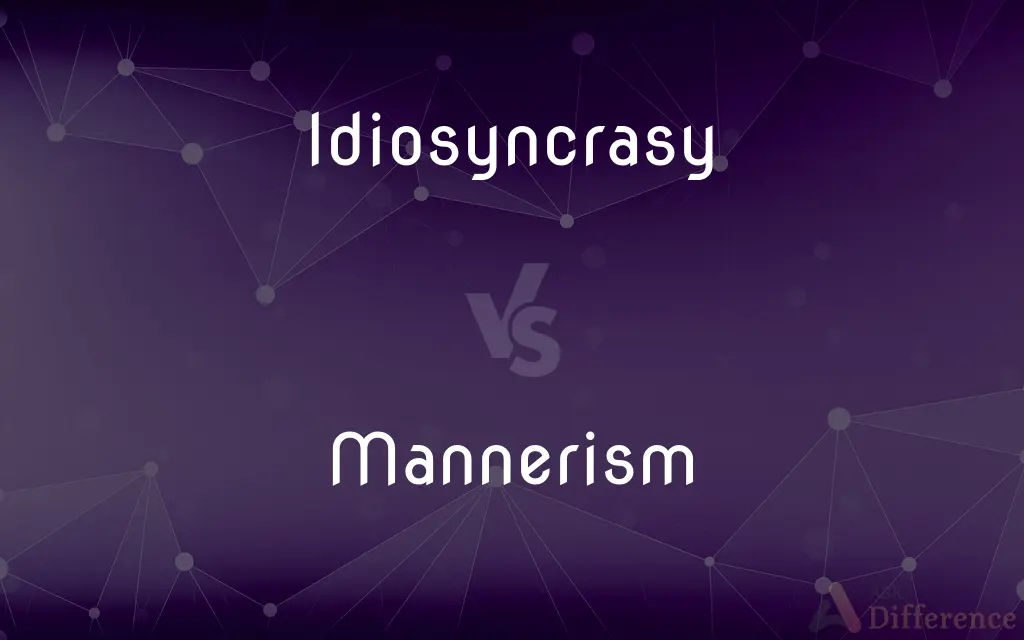Idiosyncrasy vs. Mannerism — What's the Difference?

Difference Between Idiosyncrasy and Mannerism
ADVERTISEMENT
Compare with Definitions
Idiosyncrasy
An idiosyncrasy is an unusual feature of a person (though there are also other uses, see below). It can also mean an odd habit.
Mannerism
Mannerism, also known as Late Renaissance, is a style in European art that emerged in the later years of the Italian High Renaissance around 1520, spreading by about 1530 and lasting until about the end of the 16th century in Italy, when the Baroque style largely replaced it. Northern Mannerism continued into the early 17th century.Stylistically, Mannerism encompasses a variety of approaches influenced by, and reacting to, the harmonious ideals associated with artists such as Leonardo da Vinci, Raphael, and early Michelangelo.
Idiosyncrasy
A mode of behaviour or way of thought peculiar to an individual
One of his little idiosyncrasies was always preferring to be in the car first
Mannerism
A distinctive behavioral trait, especially one that calls attention to itself; an idiosyncrasy.
Idiosyncrasy
An abnormal physical reaction by an individual to a food or drug.
ADVERTISEMENT
Mannerism
Exaggerated or affected style in an art
Films characterized by excessive artifice and mannerism.
Idiosyncrasy
A structural or behavioral characteristic peculiar to an individual or group.
Mannerism
Mannerism An artistic style of the late 1500s characterized by distortion of elements such as scale and perspective.
Idiosyncrasy
A physiological or temperamental peculiarity.
Mannerism
A noticeable personal habit, a verbal or other (often, but not necessarily unconscious) habitual behavior peculiar to an individual.
Idiosyncrasy
An unusual individual reaction to food or a drug.
Mannerism
Exaggerated or affected style in art, speech, or other behavior.
Idiosyncrasy
A behavior or way of thinking that is characteristic of a person.
Mannerism
In literature, an ostentatious and unnatural style of the second half of the sixteenth century. In the contemporary criticism, described as a negation of the classicist equilibrium, pre-Baroque, and deforming expressiveness.
Idiosyncrasy
A language or behaviour that is particular to an individual or group.
Mannerism
In fine art, a style that is inspired by previous models, aiming to reproduce subjects in an expressive language.
Idiosyncrasy
(medicine) A peculiar individual reaction to a generally innocuous substance or factor.
Mannerism
Adherence to a peculiar style or manner; a characteristic mode of action, bearing, behavior, or treatment of others.
Idiosyncrasy
A peculiarity that serves to distinguish or identify.
He mastered the idiosyncrasies of English spelling and speech.
Mannerism
Adherence to a peculiar style or manner carried to excess, especially in literature or art.
Mannerism is pardonable,and is sometimes even agreeable, when the manner, though vicious, is natural . . . . But a mannerism which does not sit easy on the mannerist, which has been adopted on principle, and which can be sustained only by constant effort, is always offensive.
Idiosyncrasy
A peculiarity of physical or mental constitution or temperament; a characteristic belonging to, and distinguishing, an individual; characteristic susceptibility; idiocrasy; eccentricity.
The individual mind . . . takes its tone from the idiosyncrasies of the body.
Mannerism
A behavioral attribute that is distinctive and peculiar to an individual
Idiosyncrasy
A behavioral attribute that is distinctive and peculiar to an individual
Mannerism
A deliberate pretense or exaggerated display
Share Your Discovery

Previous Comparison
Fingerprint vs. Dactyloscopy
Next Comparison
Location vs. Vicinity














































